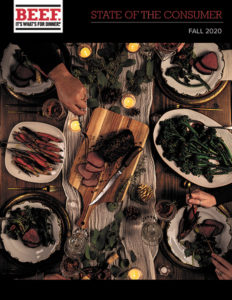
I know I’m not alone in being pretty happy to see 2020 end. It was quite a year. When I talk to other parents around my age, the consensus seems to be that this past year will be what we refer to when we’re telling our grandkids how tough we had it. Our generation’s shared story of “walking to school uphill in snow”, if you will.
But at the same time, I think we can all agree that it’s a bit tiresome continuing to complain about the year that was 2020. None of us was immune to negative impacts the year and its challenges brought us, even if those impacts looked different for each of us individually.
So, this column will not continue with the “bellyaching,” but focus on how some of the shifts in consumer behavior and perceptions over the past nine months impact the beef industry specifically. And guess what? There’s actually some positive news!!
 In December, some great consumer insight was released by the National Cattlemen’s Beef Association (NCBA), a contractor to the Beef Checkoff. A thorough report titled “State of the Consumer, Fall 2020” is now available at BeefResearch.org, and contains really interesting data and trends from the past several months. This report was compiled and analyzed by a Checkoff-funded research team, and provides some useful information for producers to better understand the consumer’s mindset after the year that was 2020, as well as what the long-term outlook might be for the beef industry.
In December, some great consumer insight was released by the National Cattlemen’s Beef Association (NCBA), a contractor to the Beef Checkoff. A thorough report titled “State of the Consumer, Fall 2020” is now available at BeefResearch.org, and contains really interesting data and trends from the past several months. This report was compiled and analyzed by a Checkoff-funded research team, and provides some useful information for producers to better understand the consumer’s mindset after the year that was 2020, as well as what the long-term outlook might be for the beef industry.
If you are interested in this type of data, I highly recommend you download the full report. I’ll share some of the key takeaways here, but you might enjoy a deeper dive into the information. Here’s what the data suggests.
Not surprisingly, as the world shifted seemingly overnight to a stay-at-home scenario, behavior shifted as well. Online media consumption during the height of the pandemic continued to grow. According to Nielsen, in the second quarter of 2020, 142.5 billion hours were spent streaming video, which is 74% higher than the same quarter in 2019. And this wasn’t just staples like Netflix and YouTube – video views on social media platforms were high, with 66% of Gen Z and 53% of Millennials claiming to have watched social media videos in the month of July alone.
Also not surprisingly, digital website visits increased, with consumers spending nearly 50 more minutes on app or web-based content through their cell phones or tablets. Regarding beef specifically, searches that took consumers to BeefItsWhatsForDinner.com also saw shifts, with notable increases in searches for classic meals like meatloaf, stuffed peppers, and London Broil recipes. There was also more focus on oven roasting recipes, which supports an overall increase in Google search behavior about roasts in general.
In terms of the impact to the food industry, the seismic shock of the pandemic-caused shutdowns resulted in a nearly 80% decrease in transactions at full-service restaurants, and over 40% decrease at quick-service restaurants at the peak of the pandemic. And while that has steadied somewhat, overall transactions still show a decline.
On the flipside of this decline in the foodservice industry, at the retail level, the opposite was true, especially in the early days of the pandemic. Even though the number of consumers claiming to be stocking up on more than they need has gone down since the beginning of the pandemic, well over half of consumers continue to stock up. Looking at meat specifically, sales in July of 2020 were 36% higher than a year prior. (For context, a 1-2% growth in a typical year would be positive.)
And if you recall some of the empty store shelves we saw in March, it’s probably not a big surprise that beef sales were quite high – there was a week in March in which beef sales were nearly 90% higher than the same week in 2019.
In terms of types of meat products consumers were stocking up on, 59% claimed to be stocking up on chicken, with 55% stocking up on ground beef, 30% stocking up on beef steaks, and 13% stocking up on plant-based proteins.
With this behavior taking place throughout the country, and the decline in foodservice transactions, the amount of cooking at home consumers were doing in the pandemic increased significantly as a result. One outcome of this has been an increase in confidence in cooking, with 62% of consumers claiming they are more knowledgeable now about selecting and preparing meat compared to pre-pandemic.
For beef, consumption and positive perceptions increased during 2020. From January to September, the percentage of consumer claiming to eat beef at least weekly increased from 67% to 72% compared to 2019, and the number of people with a positive perception about beef also increased, with positive perceptions reaching 70% overall for the first time. What’s more, positive perceptions specifically regarding how cattle are raised increased 18% compared to 2019.
If you’d enjoy reading the full report, I encourage you to visit BeefResearch.org to download it. You’ll also find some other fascinating studies and reports on a variety of aspects about beef production, consumption, consumer behavior and more.
As I close out this month’s column, I hope everyone stays safe and healthy in 2021, and that we all experience better days ahead. Happy New Year!
 By Jill Scofield | Director of Producer Relations, California & Nevada Beef Council
By Jill Scofield | Director of Producer Relations, California & Nevada Beef Council
